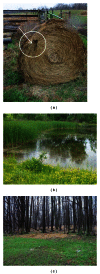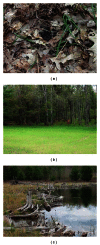An Effort to Isolate Mycobacterium bovis from Environmental Substrates during Investigations of Bovine Tuberculosis Transmission Sites (Cattle Farms and Wildlife Areas) in Michigan, USA
- PMID: 23738108
- PMCID: PMC3658856
- DOI: 10.5402/2011/787181
An Effort to Isolate Mycobacterium bovis from Environmental Substrates during Investigations of Bovine Tuberculosis Transmission Sites (Cattle Farms and Wildlife Areas) in Michigan, USA
Abstract
Deer movements on cattle farms, wildlife feeding, and livestock management practices in Michigan are thought to create opportunities for indirect transmission of Mycobacterium bovis via environmental substrates. To confirm the presence of viable M. bovis in the environment, substrates were collected from 13 farms with culture-confirmed M. bovis in cattle and 5 sites with high prevalence of M. bovis in free-ranging deer. None of the samples processed for mycobacterial culture were positive for M. bovis. Agent, host, and landscape-level factors decrease the probability of detecting M. bovis in the environment using conventional mycobacterial culture. Molecular techniques that increase the probability of M. bovis detection in environmental substrates should be applied to known sites of M. bovis transmission in Michigan. In the interim, epidemiological investigations informed by experimental studies will be most effective in characterizing M. bovis persistence in the environment and its role in the indirect interspecies transmission of M. bovis.
Figures




References
-
- Schmitt SM, Fitzgerald SD, Cooley TM, et al. Bovine tuberculosis in free-ranging white-tailed deer from Michigan. Journal of Wildlife Diseases. 1997;33(4):749–758. - PubMed
-
- Animal Industry Division, Michigan Department of Agriculture. 2010.
-
- Schmitt SM, O’Brien DJ, Bruning-Fann CS, Fitzgerald SD. Bovine tuberculosis in Michigan wildlife and livestock. Annals of the New York Academy of Sciences. 2002;969:262–268. - PubMed
-
- Whipple DL, Jarnagin JL, Payeur JB. DNA fingerprinting of Mycobacterium bovis isolates from animals in northeast Michigan. In: Proceedings of the 9th International Symposium of the World Association of Veterinary Laboratory Diagnosticians; 1999; College Station, Tex, USA. World Association of Veterinary Laboratory Diagnosticians;
-
- O’Brien DJ, Schmitt SM, Fitzgerald SD, Berry DE, Hickling GJ. Managing the wildlife reservoir of Mycobacterium bovis: the Michigan, USA, experience. Veterinary Microbiology. 2006;112(2–4):313–323. - PubMed
LinkOut - more resources
Full Text Sources

